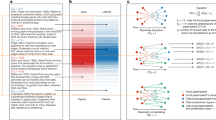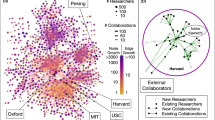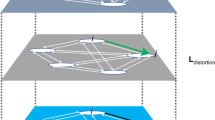Abstract
Theories of innovation emphasize the role of social networks and teams as facilitators of breakthrough discoveries1,2,3,4. Around the world, scientists and inventors are more plentiful and interconnected today than ever before4. However, although there are more people making discoveries, and more ideas that can be reconfigured in new ways, research suggests that new ideas are getting harder to find5,6—contradicting recombinant growth theory7,8. Here we shed light on this apparent puzzle. Analysing 20 million research articles and 4 million patent applications from across the globe over the past half-century, we begin by documenting the rise of remote collaboration across cities, underlining the growing interconnectedness of scientists and inventors globally. We further show that across all fields, periods and team sizes, researchers in these remote teams are consistently less likely to make breakthrough discoveries relative to their on-site counterparts. Creating a dataset that allows us to explore the division of labour in knowledge production within teams and across space, we find that among distributed team members, collaboration centres on late-stage, technical tasks involving more codified knowledge. Yet they are less likely to join forces in conceptual tasks—such as conceiving new ideas and designing research—when knowledge is tacit9. We conclude that despite striking improvements in digital technology in recent years, remote teams are less likely to integrate the knowledge of their members to produce new, disruptive ideas.
This is a preview of subscription content, access via your institution
Access options
Access Nature and 54 other Nature Portfolio journals
Get Nature+, our best-value online-access subscription
$29.99 / 30 days
cancel any time
Subscribe to this journal
Receive 51 print issues and online access
$199.00 per year
only $3.90 per issue
Buy this article
- Purchase on Springer Link
- Instant access to full article PDF
Prices may be subject to local taxes which are calculated during checkout




Similar content being viewed by others
Data availability
The datasets used in this paper are available at https://lyl010.github.io/ and https://doi.org/10.6084/m9.figshare.21295725. Source data are provided with this paper.
Code availability
All code is available at https://lyl010.github.io/.
References
Burt, R. S. Structural holes and good ideas. Am. J. Sociol. 110, 349–399 (2004).
Jones, B. F. The rise of research teams: benefits and costs in economics. J. Econ. Perspect. 35, 191–216 (2021).
Muthukrishna, M. & Henrich, J. Innovation in the collective brain. Phil. Trans. R. Soc. B 371, 20150192 (2016).
Wuchty, S., Jones, B. F. & Uzzi, B. The increasing dominance of teams in production of knowledge. Science 316, 1036–1039 (2007).
Bloom, N., Jones, C. I., Van Reenen, J. & Webb, M. Are ideas getting harder to find? Am. Econ. Rev. 110, 1104–1144 (2020).
Park, M., Leahey, E. & Funk, R. J. Papers and patents are becoming less disruptive over time. Nature 613, 138–144 (2023).
Weitzman, M. L. Recombinant growth. Q. J. Econ. 113, 331–360 (1998).
Uzzi, B., Mukherjee, S., Stringer, M. & Jones, B. Atypical combinations and scientific impact. Science 342, 468–472 (2013).
Polanyi, M. The Tacit Dimension (Univ. Chicago Press, 1966).
Jones, B. F. The burden of knowledge and the ‘death of the renaissance man’: is innovation getting harder? Rev. Econ. Stud. 76, 283–317 (2009).
Leahey, E. & Reikowsky, R. C. Research specialization and collaboration patterns in sociology. Soc. Stud. Sci. 38, 425–440 (2008).
Cummings, J. N. & Kiesler, S. Collaborative research across disciplinary and organizational boundaries. Soc. Stud. Sci. 35, 703–722 (2005).
Freeman, R., Ganguli, I. & Murciano-Goroff, R. Why and Wherefore of Increased Scientific Collaboration Working Paper 19819 (NBER, 2014); https://doi.org/10.3386/w19819.
Fleming, L., Mingo, S. & Chen, D. Collaborative brokerage, generative creativity, and creative success. Adm. Sci. Q. 52, 443–475 (2007).
Lahiri, N. Geographic distribution of R&D activity: how does it affect innovation quality? Acad. Manage. J. 53, 1194–1209 (2010).
Maskell, P., Bathelt, H. & Malmberg, A. Building global knowledge pipelines: the role of temporary clusters. Eur. Plan. Stud. 14, 997–1013 (2006).
Cramton, C. D. The mutual knowledge problem and its consequences for dispersed collaboration. Organ. Sci. 12, 346–371 (2001).
Azoulay, P., Zivin, J. S. G. & Sampat, B. The Diffusion of Scientific Knowledge across Time and Space: Evidence from Professional Transitions for the Superstars of Medicine Working Paper 16683 (NBER, 2011); https://doi.org/10.3386/w16683.
Catalini, C. Microgeography and the direction of inventive activity. Manage. Sci. 64, 4348–4364 (2018).
Brucks, M. S. & Levav, J. Virtual communication curbs creative idea generation. Nature 605, 108–112 (2022).
Yang, L. et al. The effects of remote work on collaboration among information workers. Nat. Hum. Behav. 6, 43–54 (2022).
Xu, F., Wu, L. & Evans, J. Flat teams drive scientific innovation. Proc. Natl Acad. Sci. USA 119, e2200927119 (2022).
Dane, E. Reconsidering the trade-off between expertise and flexibility: a cognitive entrenchment perspective. Acad. Manage. Rev. 35, 579–603 (2010).
Azoulay, P., Fons-Rosen, C. & Zivin, J. S. G. Does science advance one funeral at a time? Am. Econ. Rev. 109, 2889–2920 (2019).
Wu, L., Wang, D. & Evans, J. A. Large teams develop and small teams disrupt science and technology. Nature 566, 378–382 (2019).
Bloom, N., Liang, J., Roberts, J. & Ying, Z. J. Does working from home work? Evidence from a Chinese experiment. Q. J. Econ. 130, 165–218 (2014).
Hinds, P. J. & Bailey, D. E. Out of sight, out of sync: understanding conflict in distributed teams. Organ. Sci. 14, 615–632 (2003).
Hinds, P. J. & Weisband, S. P. in Virtual Teams That Work: Creating Conditions for Virtual Team Effectiveness (eds Gibson, C. B. & Cohen, S. G.) 21–36 (Wiley, 2003).
Funk, R. J., & Owen-Smith, J. A dynamic network measure of technological change. Manage. Sci. 63, 791–817 (2017).
Watson, J. D. & Crick, F. H. Molecular structure of nucleic acids: a structure for deoxyribose nucleic acid. Nature 171, 737–738 (1953).
Lander, E. S. et al. Initial sequencing and analysis of the human genome. Nature 409, 860–921 (2001).
Orús, R. & Vidal, G. Infinite time-evolving block decimation algorithm beyond unitary evolution. Phys. Rev. B 78, 155117 (2008).
Tamano, M., Okuda, H., Yajima, H., Hirose, T. & Kagaya, N. Retrieval method using image information. US patent US5857199A (1999).
Waltman, L., Tijssen, R. J. W. & van Eck, N. J. Globalisation of science in kilometres. J. Informetr. 5, 574–582 (2011).
Kiesler, S. & Cummings, J. N. What do we know about proximity and distance in work groups? A legacy of research. Distributed Work 1, 57–80 (2002).
Van Noorden, R. Global mobility: science on the move. Nature 490, 326–329 (2012).
Holten, D. & van Wijk, J. J. Force-directed edge bundling for graph visualization. Comput. Graph. Forum 28, 983–990 (2009).
Wang, K. et al. Microsoft Academic Graph: when experts are not enough. Quant. Sci. Stud. 1, 396–413 (2020).
Shen, Z., Ma, H. & Wang, K. A Web-scale system for scientific knowledge exploration. In Proc. ACL 2018, System Demonstrations 87–92 (Association for Computational Linguistics, 2018); https://aclanthology.org/P18-4015/.
Rajkumar, K., Saint-Jacques, G., Bojinov, I., Brynjolfsson, E. & Aral, S. A causal test of the strength of weak ties. Science 377, 1304–1310 (2022).
Kaltenberg, M., Jaffe, A. B. & Lachman, M. The Age of Invention: Matching Inventor Ages to Patents Based on Web-Scraped Sources Working Paper 28768 (NBER, 2021); https://www.nber.org/papers/w28768.
Haeussler, C. & Sauermann, H. Division of labor in collaborative knowledge production: the role of team size and interdisciplinarity. Res. Policy 49, 103987 (2020).
Cui, H., Wu, L. & Evans, J. A. Aging scientists and slowed advance. Preprint at https://arxiv.org/abs/2202.04044 (2022).
Granovetter, M. S. The strength of weak ties. Am. J. Sociol. 78, 1360–1380 (1973).
Mors, M. L. & Waguespack, D. M. Fast success and slow failure: the process speed of dispersed research teams. Res. Policy 50, 104222 (2021).
Correia, S. Correia S. reghdfe: Estimating linear models with multi-way fixed effects. 2016 Stata Conference https://econpapers.repec.org/paper/bocscon16/24.htm (2016).
Acknowledgements
We thank F. Xu, J. A. Evans, F. Neffke, J. Huang, G. Presidente, H. Youn, Y. Lin, M. Frank and S. Bana for helpful comments or discussions. We are grateful for support from Citi, the Dieter Schwarz Foundation (C.B.F.), the Richard King Mellon Foundation, the Alfred P. Sloan Foundation and the National Science Foundation grant SOS:DCI 2239418 (L.W.).
Author information
Authors and Affiliations
Contributions
Y.L., C.B.F. and L.W. collaboratively conceived and designed the study, contributed to the interpretation of data, and drafted, revised and edited the manuscript. Y.L. analysed the data and implemented the models.
Corresponding authors
Ethics declarations
Competing interests
The authors declare no competing interests.
Peer review
Peer review information
Nature thanks Melanie Brucks and the other, anonymous, reviewer(s) for their contribution to the peer review of this work.
Additional information
Publisher’s note Springer Nature remains neutral with regard to jurisdictional claims in published maps and institutional affiliations.
Extended data figures and tables
Extended Data Fig. 1 The robust, negative relationship between collaboration distance and disruption probability against team sizes, periods, and fields.
For 20,134,803 research papers published between 1960 and 2020, and 4,060,564 patent applications filed between 1976 and 2020, we show that the negative association between collaboration distance and the probability of producing disruptive work (D > 0) is robust against team sizes (a,d), team periods (b,e), and fields of study (c,f). For each value of the controlled variable (e.g., team size equals two for the blue curve in Panel a), the gray dotted line marks the average disruption probability across all distances. We then display the relative probability of disruption (colored curves), calculated as the ratio of disruption probability for the group of given collaboration distance to the average probability across all distances. The plotted curves have been normalized by dividing their raw values by the group mean, so that the intercepts are not meaningful. We note that Panels b and e appear to show that the remote penalty has strengthened after 2000. However, this effect is confounded by the increase in team size over this time period. See Extended Data Table 1–2 for the effect of distance on innovation when a host of control variables are accounted for.
Extended Data Fig. 2 Verifying the lower performance of remote teams using alternative measures of collaboration distance.
For 20,134,803 research papers published between 1960 and 2020, and 4,060,564 patent applications filed between 1976 and 2020, we calculate three different, alternative measures of collaboration distance other than our main specification—the average geographic distance between team members. These include the maximum distance between team members34 (a); the average distance between the unique cities where team members are located (b); and a colocation index varying from zero to one, which measures the probability that a randomly selected pair of team members are in the same location45 (c). This colocation index is a continuous variable that complements the binary measures of onsite and remote teams, as it captures boundary cases where some but not all members of a remote team are onsite. In Panel a–c, the gray dotted lines mark the average disruption probability for papers and patents across all distances. The colored curves (or bars) mark the relative probability of disruption, calculated as the ratio of disruption probability for the analyzed group to the average probability across all distances.
Extended Data Fig. 3 Verifying the lower performance of remote teams using alternative measures of innovation.
For 20,134,803 research papers published between 1960 and 2020, and 4,060,564 patent applications filed between 1976 and 2020, we calculate two alternative measures of innovation and find that remote teams are consistently less likely to disrupt science and technology than onsite teams. The percentile of the average D-score falls from 89 to 84 for papers (a) and from 76 to 67 for patents (b) across the full sample. The probability of proposing new scientific concepts decreases from 0.40% to 0.32% for papers and the probability of introducing new technology codes decreases from 3.33% to 3.22% for patents, when switching from onsite to remote (c). The gray dotted line marks the probability of introducing new concepts or code for an average paper (0.37%) or patent (3.24%). The color bars show the relative probability, calculated as the ratio of probability for the analyzed group relative to the population’s average probability.
Extended Data Fig. 4 Onsite teams conceive, and remote teams perform.
We analyzed 89,575 author contribution disclosures underlying papers across four journals, including Nature, Science, PNAS, and PLOS ONE, between 2003 and 2020. We associate authors with their contribution to four research activities, including “conceiving research,” “performing experiments,” “analyzing data,” and “writing the paper.” For each of the 21,373 scientists who worked in both onsite and remote teams, we track the distribution of their contributions across four activities within each paper and average this distribution within the onsite-team and remote-team papers they published, respectively. This way, we obtained two distributions for each scientist. We then averaged these two distributions across all the 21,373 scientists in our sample. Finally, we displayed the obtained distributions using the Gaussian kernel density estimate. We observe that the key contribution of the same scientist, marked by the peak of the density curves, shifted from “conceiving research” to “performing experiments” when they switched from onsite to remote. These two distributions are significantly different from each other (Chi-squared test statistic = 3188, p-value < 0.001).
Extended Data Fig. 5 Different scaling patterns of conceptual and technical activities.
Our author contribution data covers disclosures from PNAS (18,354), Nature (9,364), Science (1,176), and PLOS ONE (60,681) between 2003 and 2020. We select PNAS (a) and PLOS ONE (b), which have the most observations, and explore the distinct scalability of engagement across research activities. We group four research activities into two broad categories according to their different scalability, including 1) conceptual tasks that contain conceiving and writing, which scale up slowly with team size (red curves), and 2) technical tasks comprising performing and analyzing, which scale up fast with team size (blue curves). As shown in the insets, while the fraction of performing members stabilizes at 0.6 as the team size increases from two to ten, the fraction of conceiving members even decreases from 0.9 to 0.4.
Extended Data Fig. 6 Inferring conceptual and technical activities.
Using the ground-truth dataset mentioned in Extended Data Fig. 5, we train a neural-network model to infer these two author roles within 16,397,750 papers where author contributions are not explicit. This machine learning model uses eight different variables to predict the dichotomy of author roles, including 1) contribution to references, defined as the overlap between references of the focal paper and all references across previously published papers for each author; 2) contribution to topics, defined as the overlap between MAG topic keywords for the focal paper and all keywords across previously published papers for each author; 3) contribution to leading the research, defined as the probability of being the first author(s); 4) contribution to managing correspondence and presentation, defined as the probability of being the corresponding author(s); 5) career age, defined as the number of years from the first publication to the publication of the focal paper for a given author, 6) citation impact, defined as the total number of citations an author has received to all previous publications; 7) topic diversity, defined as the total number of unique MAG topic keywords across previous publications, and finally; 8) publication productivity, defined as the total number of previous papers until the publication of the focal paper. The machine learning model gives a precision of 0.790 and a recall of 0.793. The predicted and empirical values of the fraction of conceptual workers are highly correlated (Pearson correlation coefficient 0.66, P-value < 0.001). The eight predictors and their contribution to the prediction are displayed. The figure is reproduced from our earlier research22.
Supplementary information
Rights and permissions
Springer Nature or its licensor (e.g. a society or other partner) holds exclusive rights to this article under a publishing agreement with the author(s) or other rightsholder(s); author self-archiving of the accepted manuscript version of this article is solely governed by the terms of such publishing agreement and applicable law.
About this article
Cite this article
Lin, Y., Frey, C.B. & Wu, L. Remote collaboration fuses fewer breakthrough ideas. Nature 623, 987–991 (2023). https://doi.org/10.1038/s41586-023-06767-1
Received:
Accepted:
Published:
Issue Date:
DOI: https://doi.org/10.1038/s41586-023-06767-1
This article is cited by
Comments
By submitting a comment you agree to abide by our Terms and Community Guidelines. If you find something abusive or that does not comply with our terms or guidelines please flag it as inappropriate.



